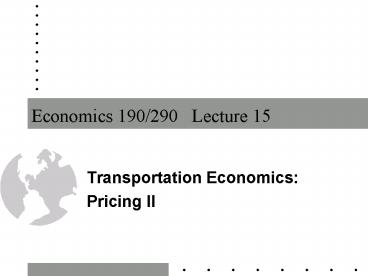Economics 190290 Lecture 15 PowerPoint PPT Presentation
1 / 24
Title: Economics 190290 Lecture 15
1
Economics 190/290 Lecture 15
- Transportation Economics
- Pricing II
2
Policy Problems
- With increasing returns to scale, then pMCltAC
will not cover costs - Private costs and benefits may differ from social
costs and benefits due to externalities - Transport might require both public supply
(roads) and private supply (drivers) how to
reflect the costs of both? - In practice, transit is underpriced in the U.S.
3
Outline
- 1) Review Social Optimum
- what would the govt provide?
- 2) Consider joint public-private problem
- e.g. financing for roads
- 3) Look at Ramsey pricing
- used when prices need to cover costs
- 4) Look at Second-best pricing
- used when some prices not optimal
4
1) Social Welfare
- Inverse demand,
- Social welfare (Net social benefits)
- where,
5
Social Optimum
- Choose Q to max Net social benefits
- or,
- Price Marginal Costs
6
2) Social Welfare (extended)
- Social welfare (Net social benefits)
- Qtraffic on road (final output)
- LLanes on the road (capacity)
- UC(Q/L)users costs (e.g. waiting)
- CC(L)capital costs (e.g. construction)
7
Social Optimum
- Choose Q to max NSB
- or,
- Price User Cost Toll!
8
Social Optimum (contd)
- Choose L to max NSB
- if CC0, then,
- Q Toll Total capital costs!
9
Results
- 1) Charge drivers a toll reflecting their
influence on total congestion - 2) If there are constant returns to scale in
construction (reasonable?), then this toll will
cover construction costs! - Question how to determine the toll?
10
Determination of toll (next lecture)
- 1) Develop an (empirical) model of traffic demand
and congestion costs, and determine the toll from
the first-order condition - 2) Just charge enough to cover all highway
costs! - But then much to charge each user, and how should
they be charged?
11
Policies used in California.
- Gasoline taxes
- Vehicle registration fees
- Drivers license fees
- Vehicle-weight fees (trucking)
- Tolls
- Not related to transportation
- Sales taxes, and bonds
12
3) Ramsey Pricing
- Suppose that there are increasing returns to
scale, so PMCltAC will not cover costs - Question
- How should prices be increased, for different
consumers, so that costs can be covered?
13
Same price to all consumers
- Choose Q to max Net social benefits, but now we
must cover some costs K! - Subject to,
- Lagrangian,
14
Same price to all consumers
- Choose Q to max L
- or,
- (Price-MC)/P l Inverse of Elasticity
15
Consumers with different prices
- Suppose there are differing consumers i, and each
type of consumer can be charged different prices - Then to max social welfare they should each be
charged prices - (Price-MC)/P k Inverse of Elasticity
16
Results
- Customers with lowest elasticities should be
charged the highest prices - This will minimize the reduction in consumption
that comes from charging prices above marginal
costs - Therefore, this policy will minimize the
deadweight loss drop in social welfare from
charging prices above MC
17
Example Post office
- MC lt AC of delivering service. So MC pricing will
not cover costs - It is constrained to charge the same for letters
to any U.S. destination! - Therefore, it charges higher prices to
first-class customers, who have less elastic
demand
18
Example Highway financing in U.S.
- Some of the financing comes from motor vehicle
use fees - This is probably the least elastic of any
transportation decision, though it does little to
reduce congestion (as tolls do) - So from Ramsey pricing, it makes sense to have
motor vehicle and drivers license fees
19
4) Second-best Pricing
- Suppose that some prices are not set at the
socially optimal level. - How will this affect the choice of price for
other commodities? - E.g. Motorists are charged prices (i.e. tolls,
gasoline tax, etc.) that are too low - How does this affect socially optimal transit
prices?
20
Second-best rule
- Suppose that commodities j are not priced
optimally. Then price i should be, - gt0 if PjgtMCj for substitute goods j
- lt0 if PjltMCj for substitute goods j
21
Result
- So if motorist charged below social MC, then we
should also charge below social MC for transit! - Why?
- Otherwise, even more people would be induce to
drive, with further pollution, and congestion.
22
Second-best transit fares for London
- Suppose that cars have congestion costs of 21
p1 / mile, and buses have 5 p / mile - Marginal costs of transit
- Case 1,
- operating and external costs considered
- Case 2,
- operating, external and capacity costs, which are
assigned to peak hours
23
Second-best transit fares for London
24
Results
- Both fares below existing, except during peak
hours - Rail fares should not be so heavily subsidized
- More persons should be using the bus (to reduce
traffic congestion), but fewer persons should be
using the train during peak hours

